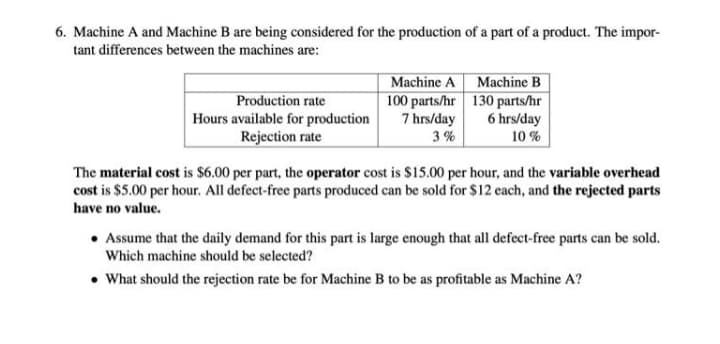6. Machine A and Machine B are being considered for the production of a part of a product. The impor- tant differences between the machines are: Machine A Machine B Production rate Hours available for production Rejection rate 100 parts/hr 130 parts/hr 6 hrs/day 10 % 7 hrs/day 3% The material cost is $6.00 per part, the operator cost is $15.00 per hour, and the variable overhead cost is $5.00 per hour. All defect-free parts produced can be sold for $12 each, and the rejected parts have no value. • Assume that the daily demand for this part is large enough that all defect-free parts can be sold. Which machine should be selected? • What should the rejection rate be for Machine B to be as profitable as Machine A?
6. Machine A and Machine B are being considered for the production of a part of a product. The impor- tant differences between the machines are: Machine A Machine B Production rate Hours available for production Rejection rate 100 parts/hr 130 parts/hr 6 hrs/day 10 % 7 hrs/day 3% The material cost is $6.00 per part, the operator cost is $15.00 per hour, and the variable overhead cost is $5.00 per hour. All defect-free parts produced can be sold for $12 each, and the rejected parts have no value. • Assume that the daily demand for this part is large enough that all defect-free parts can be sold. Which machine should be selected? • What should the rejection rate be for Machine B to be as profitable as Machine A?
Managerial Economics: A Problem Solving Approach
5th Edition
ISBN:9781337106665
Author:Luke M. Froeb, Brian T. McCann, Michael R. Ward, Mike Shor
Publisher:Luke M. Froeb, Brian T. McCann, Michael R. Ward, Mike Shor
Chapter5: Investment Decisions: Look Ahead And Reason Back
Section: Chapter Questions
Problem 4MC
Related questions
Question

Transcribed Image Text:6. Machine A and Machine B are being considered for the production of a part of a product. The impor-
tant differences between the machines are:
Machine A Machine B
100 parts/hr 130 parts/hr
Production rate
Hours available for production
Rejection rate
7 hrs/day
6 hrs/day
3 %
10 %
The material cost is $6.00 per part, the operator cost is $15.00 per hour, and the variable overhead
cost is $5.00 per hour. All defect-free parts produced can be sold for $12 each, and the rejected parts
have no value.
Assume that the daily demand for this part is large enough that all defect-free parts can be sold.
Which machine should be selected?
• What should the rejection rate be for Machine B to be as profitable as Machine A?
Expert Solution
This question has been solved!
Explore an expertly crafted, step-by-step solution for a thorough understanding of key concepts.
This is a popular solution!
Trending now
This is a popular solution!
Step by step
Solved in 3 steps

Recommended textbooks for you

Managerial Economics: A Problem Solving Approach
Economics
ISBN:
9781337106665
Author:
Luke M. Froeb, Brian T. McCann, Michael R. Ward, Mike Shor
Publisher:
Cengage Learning

Managerial Economics: A Problem Solving Approach
Economics
ISBN:
9781337106665
Author:
Luke M. Froeb, Brian T. McCann, Michael R. Ward, Mike Shor
Publisher:
Cengage Learning